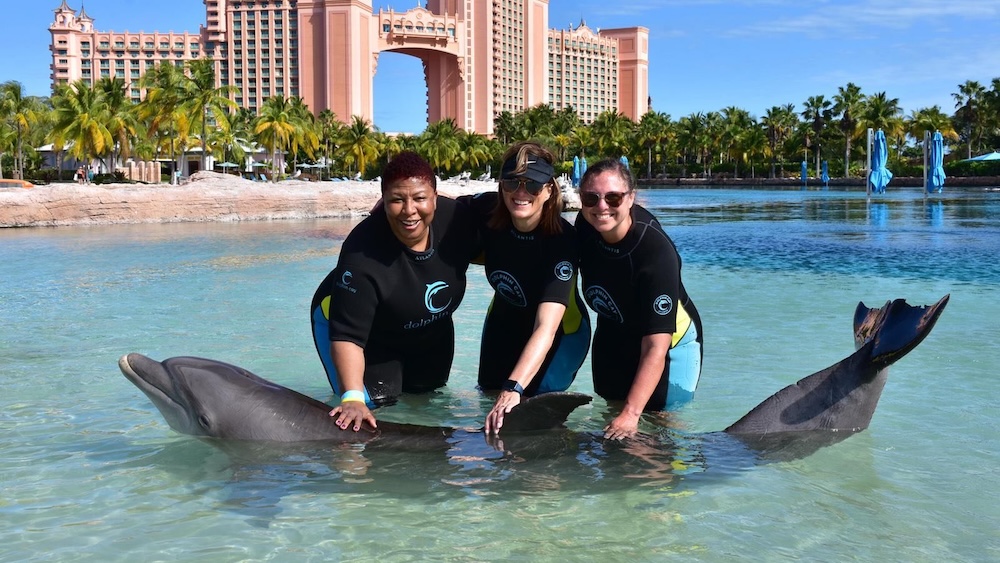



Planner Liz Lathan modeled an event held at Atlantis Paradise Island in the Bahamas after the results of a study on ROE, which prescribed hands-on adventures and an enthusiastic welcome to keep the positive vibes flowing throughout the four-day event.
When it comes to Return on Emotion (ROE), what emotions are we trying to drive, exactly? “What you’re trying to achieve is a sentiment about your brand, about your event, about your experience,” said Amanda Armstrong, Encore’s senior vice president of communications and industry relations. “So … on the whole, you want positive, but you also want impactful.” She also alludes to a roller coaster — that taking an audience “on highs and lows” can create a more meaningful experience.
“The approach that we took with our research specifically was: With the intent to drive business, what emotions do you need to evoke?”
— Community Factory’s Liz Lathan, speaking about a 2021 research study on ROE by her former event agency, Haute
Community Factory and Club Ichi cofounder Liz Lathan, CMP, likens emotional engagement to an ever-changing journey as well. Lathan’s former marketing agency, Haute, (now Brand Revolution), who trademarked the phrase “return on emotion” in 2022, conducted a year-long study on the metric in 2021 to determine which emotions are most influential in driving business at events. Five were identified: hopeful, adventurous, active, accepted, and motivated — or HAAAM, for short.
Lathan, who cofounded Haute and served as its CMO from 2018 to 2022, said that “when you’re evoking emotions at an event,” you have to understand your purpose and what you’re trying to accomplish. “The approach that we took with our research specifically was: With the intent to drive business, what emotions do you need to evoke?” She emphasized that when and where they evoke those emotions is crucial — in fact, it’s changed how she plans the event journey entirely. For example, when planning a three-day conference, she said, she will “actually label where they need to happen in the event.”
Lathan outlined a sample plan for eliciting the five emotions (HAAAM), beginning with registration — which can easily be the worst part of an event, she said. “You stand in a long line … or it’s a frictionless experience where you don’t even see a human, you just get your stuff and then you get on your cell phone to see if anyone else is there and not feel lonely.” This event pain point is an ideal opportunity to introduce a feeling of acceptance, by “having actual humans [there to] welcome you, making it feel like you are in the right place,” she said, “and that there are people that you can connect with. Starting with acceptance at the very opening moment can change how you view this.”

Liz Lathan designed her event’s welcome reception at the airport to kick off attendees’ emotional journey.
Lathan arranged for a welcome party complete with pompoms and signs to greet attendees at the Nassau airport, so that the “moment of acceptance didn’t start” on site at the registration area, she said. “It started at the airport.”
The opening keynote is a prime opportunity for instilling hope into the audience, which, when followed by an activity that makes it easy for attendees to engage with each other, checks off the active box. Lathan says this is the moment to encourage conversations — “making sure that the energy comes up so that people feel like, ‘I’ve got another day and a half here, what am I doing that’s contributing to something that’s going to happen later in the event?’”
The first afternoon or evening is an ideal opportunity for adventure. For example, during an industry summit Lathan hosted for Haute in 2022 at Atlantis Paradise Island in the Bahamas, attendees had an opportunity to swim with the dolphins and get up close with other sea creatures [see photo at top].
But it doesn’t necessarily have to be an activity with such wow factor — it’s just about encouraging attendees to get out of their comfort zone, if only for a short time. It can even be a passive experience. “We found with our research that if they’re watching someone else do something,” Lathan said — like a hot wings challenge, she joked — that will suffice. It’s about “evoking those emotions that releases dopamine, oxytocin, and serotonin, which happen to be the three chemicals that drive happiness.”
On the final day is when to push the motivation piece — “so when they leave,” Lathan said, “[they’re thinking about] what they can do next,” whether it’s registering for the next event or following up on a sales lead.
Jennifer N. Dienst is senior editor at Convene.
 Everything You Need
Everything You Need
to Know About ROE
This article and those listed below are part of Convene’s April 2025 issue cover and CMP Series story package.

 Everything You Need
Everything You Need



